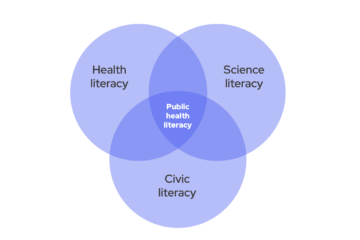My first job out of college was as a Head Start teacher. I had a classroom full of 20 three-year-olds, and I’m not afraid to admit (now) that I had NO IDEA what I was doing. I was the very definition of “fake it till you make it” that first year. Thankfully, my students put up with me, and I ended up spending five years as an early childhood educator.
Now, 15 years later, I’m working closely with cities and advocates on the CityHealth initiative, a project of the de Beaumont Foundation and Kaiser Permanente that works to improve the health and quality of life for urban residents across the nation. One of the policies on the CityHealth platform is high-quality pre-Kindergarten education. CityHealth just released a report that outlines the characteristics of what makes an early education program “high quality” — things like class size, teacher-to-child ratio, professional development, and teacher qualifications. Read Pre-K in American Cities, by CityHealth and the National Institute for Early Education Research.
If you had told 22-year-old me that the work I was doing at Head Start was actually going to impact the future health of my students, I would have put you in time-out. My goal was to teach children, not treat them. However, research shows that participation in top-notch early education programs has a profound impact on health. When done right, all children can benefit from early childhood education, regardless of family income or zip code. Consider these findings:
- For programs that incorporate certain health targets, such as immunizations and screenings, children show increased visits to pediatricians and dentists.
- Children who attend high quality pre-K programs are less likely to smoke and have lower rates of teen pregnancy.
- They are more likely to obtain more years of schooling and have higher lifetime wages (which is correlated with better health outcomes).
- Participants are less likely to commit crimes, and are less likely to be obese.
Pre-K is also a sound investment. According to Nobel Prize-winning economist James Heckman, for every dollar spent on high quality early education, there’s a return of 7 to 10 dollars.
Anecdotally, I saw the impact the Head Start program made on families every day. We fed children two meals and several snacks every day. We brought in students from Howard University’s College of Dentistry to perform screenings and provide referrals for nearby dentists. My colleagues and I helped children learn the skills necessary for self-control and emotional intelligence, which set them on a path of success in school settings. It was a demanding job, and also extremely rewarding.
But as folks in education know all too well, this is an individual-by-individual approach. The children in these programs benefit, but too many children don’t have access to high-quality programs. That puts many children at a disadvantage — in terms of education and health — before they even begin kindergarten. That’s why I went back to school to get a master’s degree in public policy. I wanted to be a part of changing the environment in which children and their families live, work, and play. We need change at the systems level so that all kids — no matter where they live — have an opportunity to fully develop their talents and abilities.
That’s what makes projects like CityHealth so exciting. By addressing community needs like housing, economic security, transportation, and the environment — and not just individual social needs — we can give every child the chance to live healthier lives.
Read Pre-K in American Cities, and let us know what you think at @deBeaumontFndtn on Twitter.




